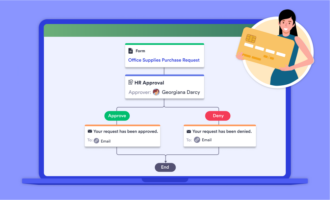How to improve purchase order tracking
- Automate repetitive processes
- Centralize tracking
- Provide adequate training for employees
- Don’t skimp on the details
- Prioritize clear communication
- Use a technology solution for purchase order tracking
Imagine a world where every purchase order is closely monitored, every shipment arrives on time, and every supplier is in sync. It’s not just the stuff of dreams — with effective purchase order tracking, it can be a reality.
Purchase orders are an integral part of running a business. However, as your business grows, it may become more difficult to keep track of purchase orders if you don’t have a system or process in place. This can lead to operational mishaps, such as late delivery of products or services. It can also cause administrative and accounting issues, resulting in extra paperwork and wasted time.
With a solid system for managing purchase orders in place, however, you can streamline processes throughout your business, in areas such as sales, shipping/delivery, inventory, and accounting.
In this article, we’ll explore the value of purchase order tracking and offer several best practices your business can implement to improve your POs. Plus, we’ll introduce you to Jotform, a simple solution for enhancing the entire purchase order tracking process.
An introduction to purchase order tracking and its significance
A purchase order is a business document that details the products and services a company is purchasing from a vendor or supplier. In your business, you may issue purchase orders to your vendors or suppliers, or other companies that want to buy your products and services may issue them to you.
Purchase orders usually include these key details:
- Buyer’s name, address, and contact information
- Seller’s name, address, and contact information
- The products and services the buyer is purchasing
- The quantity of items they’re purchasing
- The price for all purchased items
- Any discounts applied
- The payment terms
- The schedule for delivery
- Business terms and conditions
Purchase order tracking refers to the process of monitoring purchase orders from the moment they’re created until the goods are delivered and the buyer has paid for them. Typically, organizations that issue purchase orders use a purchase order tracking system to monitor order placement, shipment status, delivery schedules, invoicing, and more.
Purchase order tracking ensures you have clear visibility into the details of each order, and you can also use it to understand where each order is in the fulfillment process. Having a centralized system for managing purchase orders enables your business to communicate the details of each order with vendors and suppliers, ensuring everyone is on the same page.
Purchase orders play an important role in several areas of the business, which is why tracking them is so critical. For example, the logistics area of your business will review purchase orders to determine how much inventory to order or how many products to deliver. The accounting department will review purchase orders when making or receiving payments. Your sales team may look at purchase orders when forecasting for the next season.
“A proper tracking process is essential for maintaining consistency and accountability,” says Brian Kroeker, president of Little Rock Printing, a custom printing company. “It helps us know exactly what has been ordered, when it’s expected, and what has been received. This helps reduce the risk of stock shortages or overstocking, both of which can tie up cash flow. Our team has found that having a reliable PO process has allowed for fewer surprises and a smoother operation overall.”
Purchase order tracking best practices
“A well-defined purchase order tracking system is important since it allows for maintaining the appropriate levels of inventory and cost management,” says Anandkumar Jeevarathinam, director at Enable Healthcare Inc., a tech solutions provider for healthcare. “A dependable system ensures efficient workflow, good practices by eliminating mistakes, and establishes confidence among suppliers and stakeholders alike.”
So, how can you create a purchase order tracking system that minimizes errors and optimizes operations? Here are a few best practices to implement:
Automate repetitive processes
“In my experience, one of the best practices for effective purchase order tracking is to automate the process as much as possible. Using digital tools can help eliminate manual errors and provide real-time updates on order status,” says Ronan Ye, founder of 3ERP, a rapid prototyping service.
For example, automating data entry for shipping dates minimizes scheduling errors, and sending automated reminders for invoice payments keeps the accounting team on track.
Centralize tracking
Keep all purchase orders and related information in a singular system so everything is easy to find, track, and manage.
“We rely on centralized dashboards that integrate POs, delivery schedules, and invoices so as to streamline processes and reduce time wastage while searching for the documents,” says Jeevarathinam. “This leads to efficient communication since team members can quickly identify issues with the work” and make any necessary changes immediately.
Provide adequate training for employees
Ensure that each employee who deals with purchase orders understands their role in the process. For example, do they know how to schedule shipping and delivery to meet the terms of the agreement? Do they know the appropriate next steps, such as notifying accounting to make a payment? Are they aware of additional inventory they have to order after a PO has been fulfilled?
Providing effective purchase order training for your team ensures that deliveries, payments, and other aspects remain on track.
Don’t skimp on the details
“Keeping detailed records and having a clear approval process for purchase orders helps ensure accuracy and accountability at every step,” says Kroeker.
Standardize purchase order documents with templates to avoid the possibility of missing key information. Ensure each purchase order form is complete — and hunt down information if it’s missing from your files. If an issue arises, blank fields in a purchase order aren’t going to help you resolve it.
Prioritize clear communication
Communication is key for effective purchase order tracking. Provide written and verbal communication with vendors and suppliers to ensure everyone is aware of important information like delivery schedules, inventory status, and payment terms. Without these details, businesses can’t track the goods and services they’re buying.
“Our vendors are assured constant and dependable communication with us,” says Jeevarathinam. “The ordering process involves placing follow-up calls and emails that help prevent unnecessary last-minute panic and keep all parties well informed.”
Use a technology solution for purchase order tracking
There are many solutions available to help you manage your purchase order tracking process; choose one with features that will benefit your business most.
When evaluating purchase order tracking software, Ye assesses its user-friendliness and looks for features that enhance usability and provide comprehensive visibility. “Real-time tracking capabilities are a must; I want to know where every order is at any given moment. Also, integration with other systems, like inventory management and accounting software, can greatly improve processes. I also value reporting features that provide insights into purchasing trends and supplier performance, helping us make informed decisions moving forward.”
Jotform: A powerful way to improve your purchase order tracking
If you’re looking for a simple, affordable tool to help your business with purchase order tracking, consider Jotform. It has all the capabilities you need to standardize and streamline your processes, including
- Hundreds of purchase order templates: Whether you need a wholesale purchase order form or a PayPal payment form, you’ll find it in our library of purchase order templates. These provide a great foundation for customizing your own form to meet your business needs. You never have to start from scratch!
- Centralized tracking: Use our order tracker table template to oversee all of your purchase orders.
- Automation: Set up automations to send purchase order data to the tracker table so you have all of the details at your fingertips in real time.
- An easy-to-use interface: Your employees, suppliers, and vendors will have no trouble filling out any document created with Jotform. They’re easy to use and don’t present a learning curve to master. Plus, your team and customers can fill out Jotform forms on any device, so they can complete them on the go on their laptop, mobile device, or tablet as needed.
In addition to helping your business with purchase orders, Jotform can support you in other areas of your business as well. From invoices to payroll, lead generation to sales, Jotform has a solution for you. It’s a powerful tool that features thousands of forms, surveys, and questionnaires to support all of your business processes.
Plus, Jotform offers many solutions beyond forms. Do you need to build a custom mobile app for your business that doesn’t require coding to set up? Or do you need electronic signature software for your important documents? Jotform has you covered. It comes with an entire suite of solutions such as AI agents, mobile app builders, e-signature software, and more.
A strong purchase order tracking system can be a game-changer for your business, and with Jotform, you can be sure your system is a well-managed one.
Photo by: Lifestylememory














Send Comment: